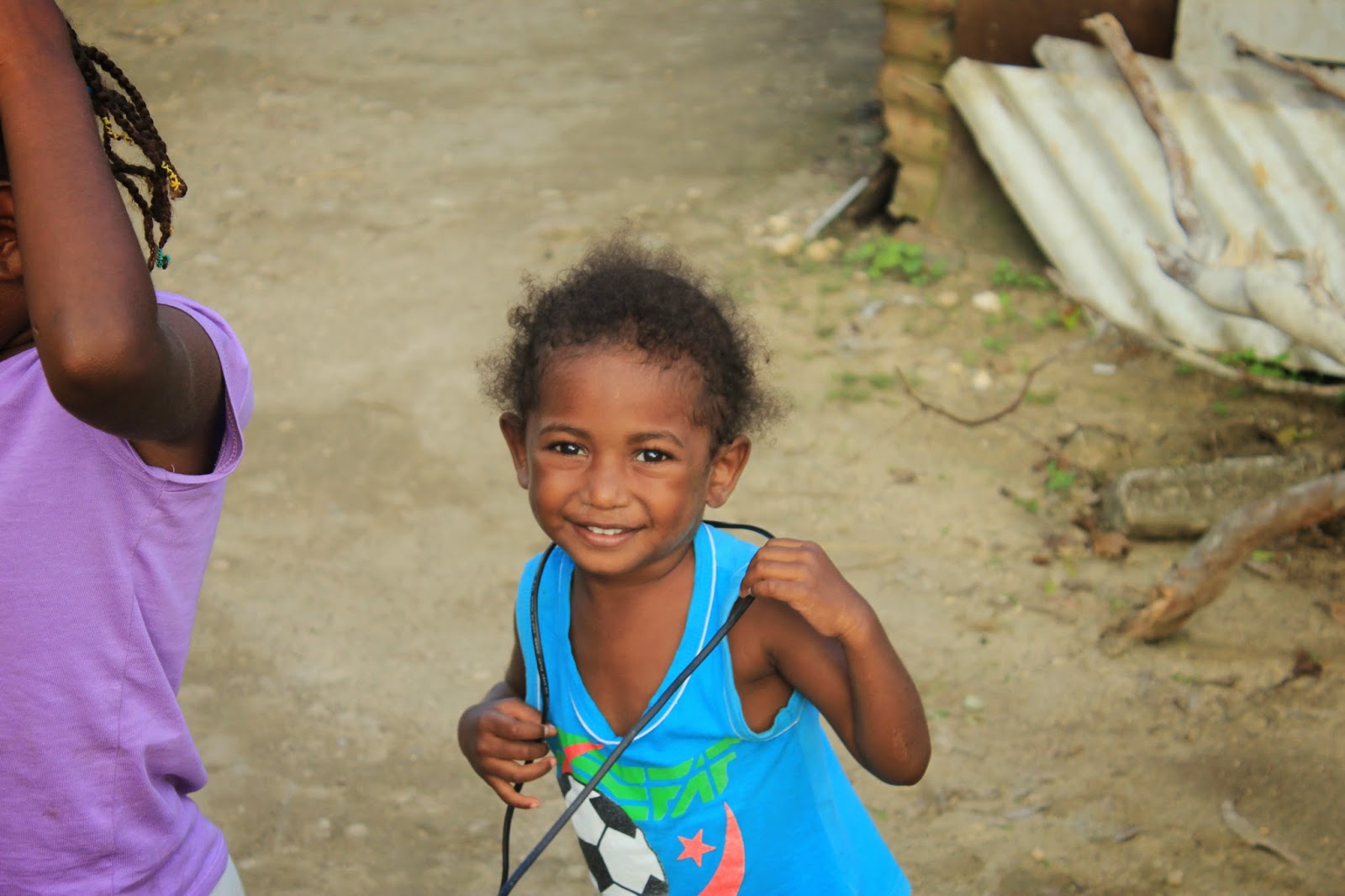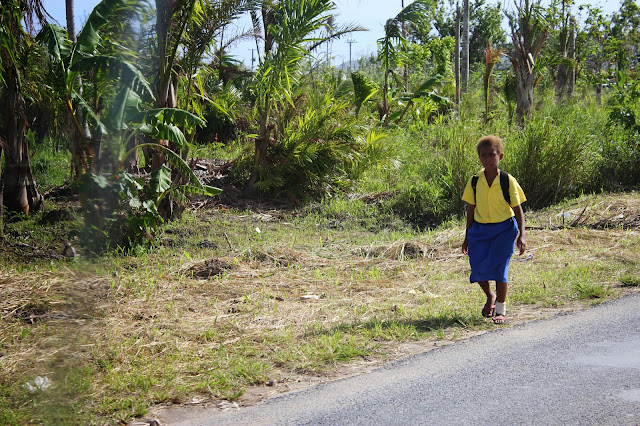Dieser Stand erregt im Vorbeilaufen unsere Aufmerksamkeit. Welches Essen wird hier verkauft? Zwar versucht die Dame es uns zu erklären, doch als wir es nach einigen Minuten immer noch nicht verstanden haben entscheiden wir uns es einfach zu probieren...
This stall draws our attention as we walk by and wonder which food is being sold here. After having tried to understand the lady's explanation for a few minutes we still have no clue and decide to just give it a go....
... und bereuen es nach ein paar Bissen. Das Essen besteht aus einer geleeartigen Masse, die sehr fettig und kokoshaltig schmeckt.. Dazu bekommen wir einen Hühnchenschenkel und ein bisschen Fetakäse, können jedoch nicht viel davon essen, da uns schlecht wird.
... which we regret after a few bites. The meal is of a jelly like texture that tastes like coconut and fat. It comes with a bit of feta cheese and a chicken wing. We stop after we have had a few bites, it is too rich and makes us feel sick.
Scroll down for English
Als Amuna zwölf Jahre alt war, las sie in einer Zeitschrift
einen Artikel über die angeblich glücklichsten Menschen der Welt. Demnach
sollten sie auf Vanuatu, auch als die „Neuen Hebriden“ bekannt, leben, einer
Inselgruppe im Südpazifik westlich der Fijiinseln. Es sei zwar ein sehr armes,
vom Rest der Welt abgeschnittenes Land, trotzdem aber so wunderschön und
fruchtbar und seine Mentalität so offen und herzlich, dass seine Bewohner
trotzdem glücklicher schienen als meist anderes Volk. Seit jeher wollte Amuna
deswegen dorthin fliegen und herausfinden, ob es so etwas wie „die
glücklichsten Menschen“ überhaupt gibt und wenn ja, was sie dazu macht. Also
sparten wir in Wellington und kauften uns von dem zurückgelegten Geld einen
Flug nach Port Vila, Vanuatus Hauptstadt auf der Insel „Efate“.
Obwohl der Südpazifik vor ein paar Wochen von Pam, einem der
stärksten Zyklonen aller Zeiten, durchgeschüttelt worden ist die Schönheit
Efates immer noch überwältigend. Entgegen all unserer Erwartungen treffen wir
auf ausnahmslos gut gelaunte, lächelnde Menschen. Unser Taxifahrer erklärt uns,
dass die Inselbewohner seit jeher ein positives Lebensgefühl haben,
unbeeinträchtigt der Zyklone, die das Land jeden Sommer heimsuchen. Es ist hier
Sitte jeder Person zu winken, die man auf der Straße trifft.
Die Ni-Vanuatu, wie sich die Einwohner selbst nennen, haben
sehr dunkle Haut, jedoch oft blonde Haare. Ihre Körper sind athletisch, allerdings
sind sie weder besonders groß, noch so breit gebaut wie andere pazifische Völker.
Sie sind melanesischer Abstammung und vor geschätzten 3000 Jahren von Papua-Neuguinea
nach Vanuatu, die Solomoninseln und Neukaledonien ausgewandert. Jede Insel hat
ihre eigene Kultur und Rituale, sogar jedes einzelne Dorf spricht seine eigene
Sprache. Als sie im 17. und 18. Jahrhundert in Folge der Kolonialisierung von
den Spaniern, Engländern und Franzosen entdeckt wurden entstand daraus
„Bislama“, die heutige Landessprache. Sie ist eine Mischung aus gebrochenem
Englisch, ein bisschen Französisch und einigen selbsterfundenen Worten. Der
durchschnittliche Erwachsene spricht demnach vier Sprachen – Bislama, seine
Dorfsprache, Englisch und Französisch. Alle von ihnen fließend. Zusammen mit
ihren Sprachen haben die Europäer auch das Christentum nach Vanuatu gebracht,
die Menschen missioniert und unzählige Kirchen errichtet. Gebetet wird vor dem
Essen, in der Schule und wann immer sich die Möglichkeit ergibt (zum Beispiel
während des Autofahrens mit christlicher Musik).
Eine der größten Attraktionen ist die Insel „Pentecoast“,
die man als spirituellen Geburtstort des Bungejumpings bezeichnen kann.
Zwischen April und Juni unterziehen sich die Männer und Jungen der Insel einer
Mutprobe, dem „Naghol“. Auf einem 20 bis 30 Meter hohen selbsterbauten Turm
binden sie sich eine Liana an den Fuß und stellen ihre Männlichkeit unter
Beweis, indem sie kopfüber herunterspringen und leicht auf dem Boden
aufschlagen. Der Zeitpunkt ist bewusst gewählt, weil zu dieser Jahreszeit die
Lianen am Stabilsten sind und dadurch die Todesrate – denn es sterben durchaus
immer wieder Menschen – verringert werden kann.
Auf anderen Inseln leben die Ni-Vanuatu am Rande aktiver
Vulkane, zusammen mit Manati, Schildkröten und Delfinen. Gefährliche Tiere gibt
es trotz tropischen Dschungels nicht, dafür aber bezaubernde Korallenriffe und
Lagunen. Fred, ein Einheimischer, nimmt sich einen Tag lang Zeit um uns Efate
zu zeigen, fährt mit uns in mehrere Dörfer und zeigt uns die schönsten Strände.
Es ist das erste Mal, dass er nach dem Zyklon um die Insel fährt und der Schock
weicht nicht von seinem Gesicht, als wir an Ruinen und entwurzelten Bäumen
vorüberfahren. Nachmittags stoppen wir bei einer Kavabar – Kava ist eine
pazifische Wurzel, die auf Vanuatu und Fiji in heißem Wasser gekocht wird und
dadurch zur Droge wird. Die Inselbewohner trinken den Kavatee und werden davon
betrunken, high und entspannt. Wir probieren ihn auch, spüren jedoch bis auf
eine taube Zunge und extreme Müdigkeit nicht besonders viel. Ni-Vanuatu
schwören jedoch darauf und trinken teilweise fünf Tassen am Tag. Vielleicht
sind sie deswegen das glücklichste Volk der Welt.
When Amuna
was twelve years old she read an article in a magazine stating that the world’s
happiest population lived on Vanuatu, a third-world-country in the south
pacific also known as “New Hebrides”. Due to their beautiful and fertile
environment and their gentle and kind mentality they were supposed to be
happier than any other people on earth. Ever since then Amuna had wanted to fly
there and see for herself whether humans could be labelled as “happiest people
on earth” and if so, why. So we saved up some money while we were working in
Wellington and spontaneously booked a flight to Port Vila, Vanuatu’s capital
which is situated on the island “Efate”.
Even though
the pacific was hit by the cyclone “Pam” a few weeks ago, Efate still looks
like paradise to us. Against all our expectation we only meet happy and smiling
people that wave at each other in the streets. Their way of living has always
been like that, explains our taxi driver, regardless of all the cyclones that
damage their home every summer.
The
islanders call themselves Ni-Vanuatu. Their skin is dark, but some of them have
amazing blonde hair. Since they are Melanesian they are not big compared to
other pacific islanders, yet very athletic. 3000 years ago they came over from
Papua-Neuguinea and settled on the Solomons, New Caledonia and Vanuatu. Every
single island has their own culture and rituals and even every single village
speaks its own language. When the Spanish, British and French discovered the
islands trying to find colonies in the 17th and 18th
century a new language called “Bislama” evolved and became the first main
language. It is basically a mixture of broken English, broken French and made
up words. Along with that Vanuatu was missioned and is now a strictly Christian
country that has a number of churches in every village. It is custom to pray on
every possible occasion, whether it’d be at school or before dinner or while
listening to religious music in the car.
One of the
biggest attractions is the “Naghol”. It is a ritual which is performed on an
island called “Pentecoast”, the spiritual birthplace of Bungeejumping. Every
year in between April and June, men and boys climb up a 20 to 30 metre high tower
that they have built with wood sticks, adjust a liana vine on their ankle and
jump off. That way they prove their manhood, especially when they actually touch
the ground with their head. The ritual is performed at a certain time of the
year when the vines are most stable.
Ni-Vanuatu on
other islands live at the foot of active volcanoes. Beautiful coral reefs and
lagoons are the homes of dolphins, manatee and turtles. Fred, a native, takes
us around Efate for a day and shows us several villages and beaches. It is his
first time driving around the island after it was hit by cyclone Pam and the horror
does not leave his face as we drive past uprooted trees and destroyed houses.
In the afternoon we stop by a kava bar to drink kava tea, Fiji’s and Vanuatu’s
national drink. It is made of a pacific root which is boilt in hot water. When
people finish work they have a few cups of kava to relax, get high and drunk at
the same time. Of course we give it a try, but we are disappointed to say that
we do not feel anything but a numb tongue and the urge to sleep. Still,
Ni-Vanuatu love it and are convinced of its powers. Maybe that is the reason
they are the happiest people alive.












.JPG)



























.JPG)













.JPG)




.JPG)

.JPG)
.JPG)
.JPG)












